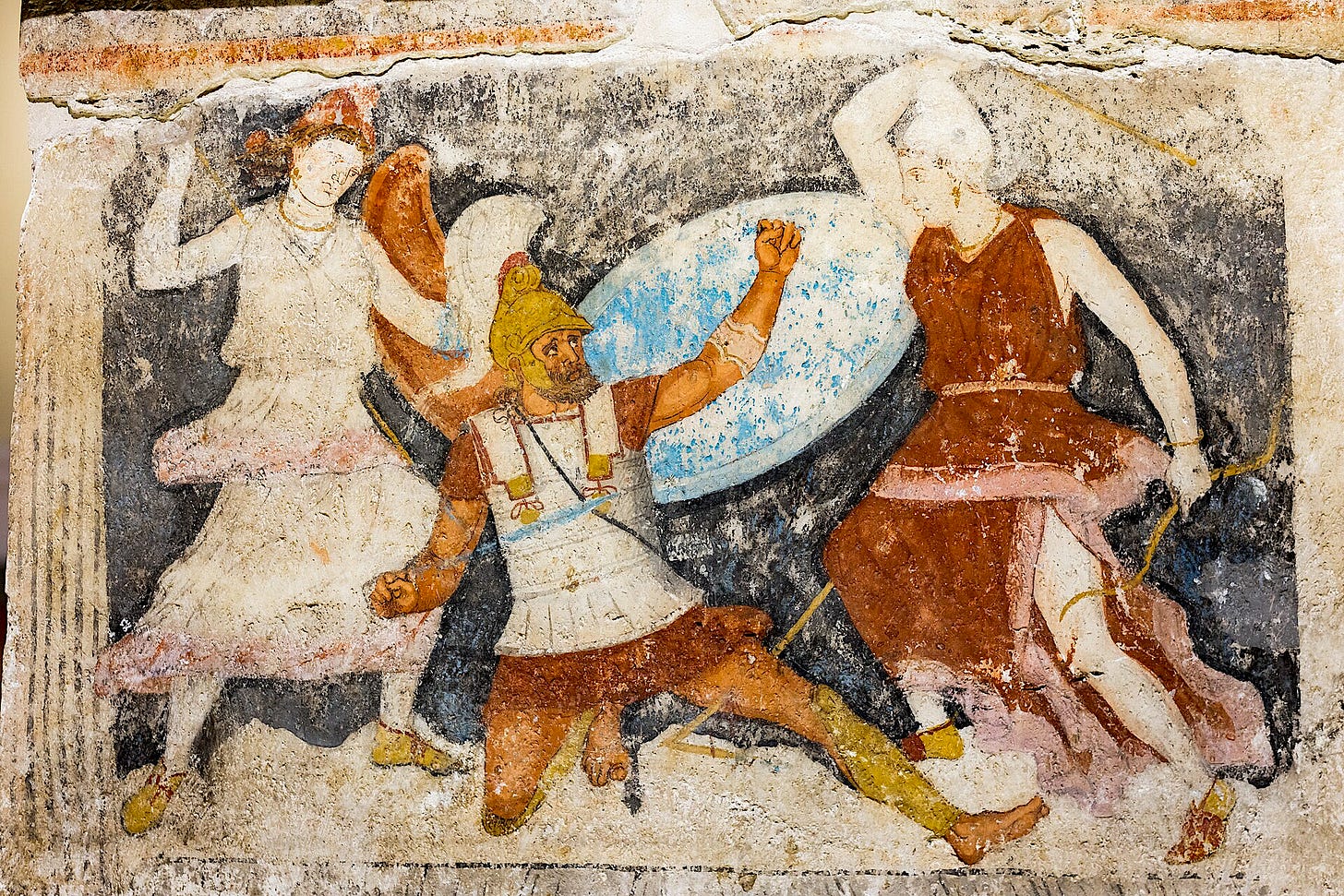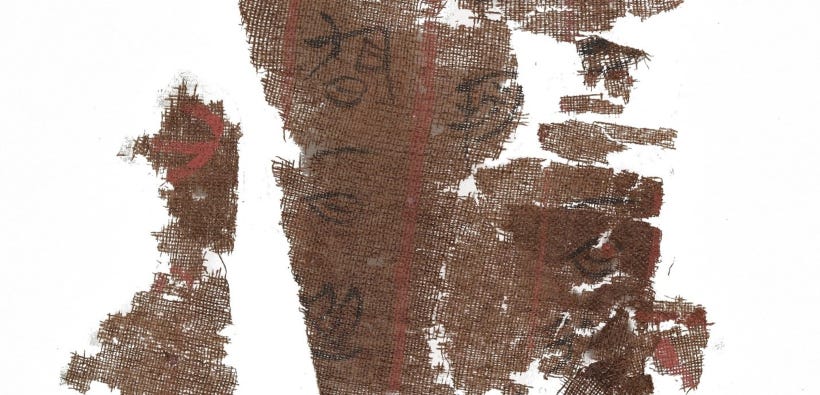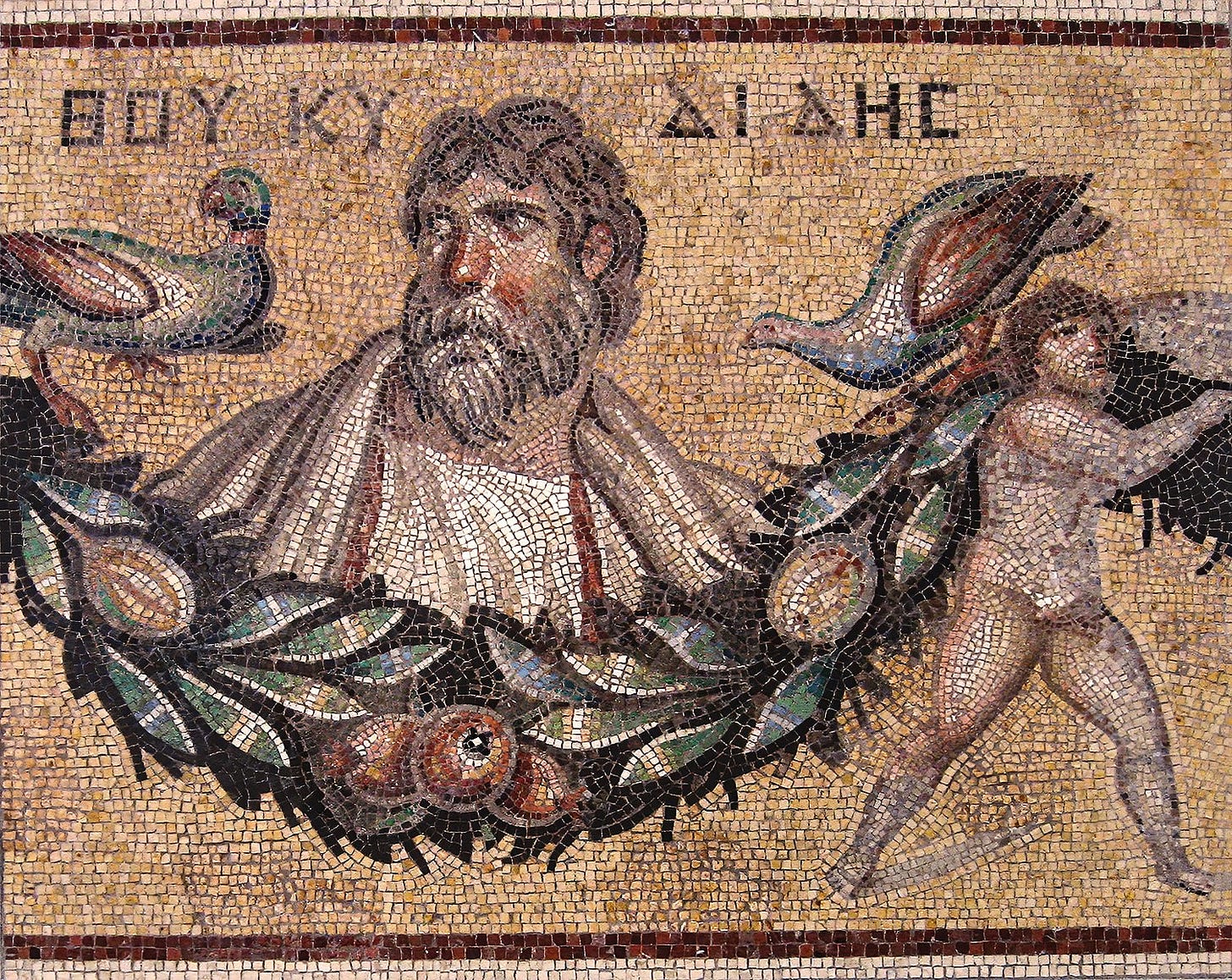Pasts Imperfect (7.10.25)
Escaping the Thucydides Trap, Sequencing Ancient Egyptian DNA & Roman Sardines, Etruscan Textile Workshops, Repatriating Chinese Manuscripts & Much More

This week, ancient historian Jennifer T. Roberts discusses Thucydides, the modern misconceptions around his “trap,” and her newly published short history of the author. Then, researchers sequence the oldest known DNA from an ancient Egyptian man while in Spain, others look at the aDNA in Roman sardines found in garum; a new game lets you create manuscripts in your own medieval scriptorium; the National Museum of Asian Art repatriates fragments of the Zidanku Silk Manuscripts; Iran repurposes Sassanid imagery from late antiquity; an Etruscan textile workshop in NYC; new ancient world journals and much more.
The Spell of Thucydides by Jennifer T. Roberts
In the year 432 BCE, representatives of several Greek states met at Sparta to discuss what course of action to adopt vis-a-vis the Athenians. Envoys from squawky Corinth sought to goad the Spartans into war by offering a provocative contrast between them—stolid, sluggish—and their restless, even frenetic, Athenian rivals. A visiting Athenian, Thucydides wrote, countered with a sobering caution:
Assess before you are actually in it how great is the incalculable element of war, how it tends to degenerate into a gamble the longer it lasts. We are only at the start, but which way it will go is a stab in the dark. (1.78.1-2)
Thucydides’ searing account of the dreadful war highlights the role played by chance in the unfolding of events, but a quite different passage from the historian’s work is quoted far more frequently in discussions of wars and their outbreaks. This is the one in which he contended that the “truest explanation” for the outbreak of the war between Athens and Sparta was that “The Spartans were forced into it because of the fear occasioned in them by the growing power of Athens” (1.23.6).
From the hundreds of pages in which Thucydides explored human nature and the ways in which it shaped affairs foreign and domestic, this single line has been cited again and again in support of the notion that changes in the balance of power make war not merely a danger but a virtual inevitability. This is something Thucydides never said; he never ascribed the very complicated series of events that led to the outbreak of the war to the relentless march of destiny.
A whole book could easily be written on the use and abuse of Thucydides in the United States alone over the past hundred years. When Americans were fighting in Vietnam (1955-1975), champions of the war pointed to the insufficient support given by the Athenians to their men in Sicily as the predictor of the ambivalent Americans’ failure, while those who opposed the war insisted that Thucydides’ account warned of the futility of overseas adventures in faraway and unfamiliar territory (Earley 2019). The first Trump administration was positively obsessed with Thucydides; Secretary of Defense James Mattis (Crowley 2017) strongly recommended that people familiarize themselves with his text. The passion for quoting Thucydides to defend every position under the sun has prompted Tufts professor Daniel Drezner to operate what he calls a “Thucydides Abuse Watch” in the journal Foreign Policy, keeping an eye out for manufactured quotations and grotesque exaggerations of Thucydidean relevance.
In 2017 Harvard scholar Graham Allison published Destined for War: Can America and China Escape Thucydides’s Trap? Placing the seal of ancient approval on a very modern theory, the book immediately became a bestseller. The war between Athens and Sparta known as the Peloponnesian War (431-404 BCE), Allison argued, showed that war resulted when a rising power challenged an existing power as had happened when Sparta’s supremacy in Greece was threatened by the expansion of Athens. The book also collected a number of other instances of such wars.

The notion, however, of a “trap” that snaps shut leaving those within it helpless to escape, entails a dismissal of the incredibly rich fabric of Thucydides’ History. What emerged from Thucydides’ account of the debate at Sparta that led to the vote for war was a malign mélange of fear, rage, and pride that crystallized at a particular juncture in history. As Thucydides himself pointed out, the era of the Peloponnesian War was rife with conflicts of many kinds—civil wars, regroupings of allies—yet at no time does the historian recur to his theme of the inevitable progression from a change in the balance of power to open warfare.
Had Thucydides regarded the march of events as predetermined, he would not have bothered to include in his History a wealth of speeches that laid bare the divisions and ambivalences that make us human. The Spartans dispatched envoys to Delphi to explore the advisability of the war even after their assembly had voted that the truce had been broken. It took the eloquence of a Pericles to persuade the Athenians to undertake the war, and then to abandon their rural homesteads to cower behind the city walls during the fighting that ensued. Several times the Athenians called second meetings of their citizens’ assembly to reconsider earlier decisions.
Rich and complex, both ambivalent and multivalent, the History offers no simple schema that can explain anything as problematic as human behavior. In Thucydides’ account, the war arises from a chain of events any of which might have gone the other way: the Corcyraeans’ rebuff of the Epidamnians’ request for aid; the Corinthians’ choice to accede to that request; the hard-debated Athenian vote to ally with Corcyra; the Athenians’ decision to stick by their decree against Megara despite the threat of war. Thucydides’ famous claim about the growth of Athens’ power, moreover, may not even be correct: his own text makes clear that Athenian power had not in fact increased in the two decades leading up to the Spartan declaration of war in 432.
Rather than distilling Thucydides down to a one-dimensional “trap,” there is an easy road to a better understanding of what can be learned from Thucydides’ text: actually reading it. The wrangling in debate, the difficulty with which decisions were made, the extreme complexity of the human mind and heart—all this rich texture will jump out from the page if one actually reads Thucydides’ remarkable work rather than relying on modern interpretations that ignore the historian’s complexity. While it seems difficult to resist the spell of Thucydides, escaping the allure of simplistic, reductive, or altogether incorrect receptions of his work means investing time and deep thought in the man and his words—all 160,000 or so of them.
Jennifer Roberts is Distinguished Professor of Classics and History at CUNY Graduate Center and the author of the new Thucydides: A Very Short Introduction.

Global Antiquity and Public Humanities
Let’s talk about fish sauce and aDNA (a field which is not just for the study of humans). In Antiquity journal, Gonçalo Espregueira Themudo, Adolfo Fernández-Fernánde, Patricia Valle Abad, and a number of other researchers look at late Roman garum, sardine use, and western Iberia. As they argue: “despite being crushed and exposed to acidic conditions, usable DNA can be recovered from ichthyological residues at the bottom of fish-salting vats. At third-century AD Adro Vello (O Grove), [in] Galicia, they confirm the use of European sardines (Sardina pilchardus) and move beyond morphology to explore population range and admixture and reveal the potential of this overlooked archaeological resource.” If you want to keep up with many of the advances in premodern DNA studies, we suggest following ancient and medieval medical historian Monica Green on Bluesky.

In other aDNA news, an article published in Nature reveals that researchers have sequenced the oldest known ancient Egyptian DNA, from a man from Nuwayrat (Nuerat, نويرات) dating to 2855–2570 cal. BCE. They remark that his DNA points to ties to North Africa and the Fertile Crescent, leading them to conclude that “Although more genomes are needed to fully understand the genomic diversity of early Egyptians, our results indicate that contacts between Egypt and the eastern Fertile Crescent were not limited to objects and imagery (such as domesticated animals and plants, as well as writing systems)6,7,8,9 but also encompassed human migration.”
Do you revel in drawing murderous medieval rabbits? Over on Steam, you can now sign up to playtest the game Scriptorium. Besides simply drawing murderous medieval bunnies, you can “[r]un your manuscript workshop, receive orders to illustrate medieval books, decorate them any way you like, send them back to clients to get paid, and unlock new jobs, decorations, and items. Welcome to your very own medieval scriptorium!” This new game pairs well with Sara J. Charles’ new book, The Medieval Scriptorium: Making Books in the Middle Ages, and is also a reminder to visit Special Collections libraries with your classes when you can.
The Smithsonian announced that the National Museum of Asian Art is repatriating a number of ancient manuscript fragments: “The Smithsonian’s National Museum of Asian Art has deaccessioned fragments of the Zidanku Silk Manuscripts (fourth–third century B.C.E.) from its collection and formally transferred them to the National Cultural Heritage Administration (NCHA) of the People’s Republic of China during a ceremony at the Chinese Embassy in Washington, D.C., May 16.” And in other repatriation news, the Netherlands recently repatriated 119 Benin Bronzes to the Nigerian government and the MFA Boston followed suit.

The Tehran Times notes that a new billboard is causing a stir in Shiraz, Iran. For a student-friendly introduction to Sasanians studies, Touraj Daryaee and Khodadad Rezakhani’s From Oxus to Euphrates: The World of Late Antique Iran is incredibly accessible and engaging.
On the SCS Blog, Joy Connolly, President of the American Council of Learned Societies, calls for support of the ACLS’s efforts to redress the gutting of the National Endowment of Humanities by DOGE this April. Dr. Connolly drew attention to the devastating consequences of this unprecedented and legally questionable assault on public funding for the humanities in the 4.17.25 issue of this newsletter. The ACLS, along with the American Historical Association (AHA) and the Modern Language Association (MLA) have brought suit against the Trump Administration. They ask for support in this (expensive) endeavor and urge readers to contact their congressional representatives to push back against the Administration's actions. (For a preliminary attempt to come to terms with the effect of these and related cuts and cancellations on archaeology see this analysis in Science.)
Archaeologists announced they have discovered a 3,500-year-old city, named Peñico, in Peru. A press release from the Ludwig Maximilian University of Munich (LMU), notes that Enrique Jiménez deciphered a new Babylonian hymn. Archaeology magazine reports that “Using artificial intelligence, the team was able to identify 30 different fragmentary pieces from the same composition, which turned out to be a previously unknown hymn consisting of 250 lines.” And finally, 22 blocks from Alexandria’s famed Pharos lighthouse have been dredged up as part of the CNRS project to virtually put the famed wonder back together.
There are some great open access (=free) new ebooks out now: There is Slavery and Honour in the Ancient Greek World, edited by David Lewis , Mirko Canevaro and Douglas Cairns; a look at the enslavement of eastern Mediterranean Romans in Alasdair Grant’s Greek Captives and Mediterranean Slavery, 1260-1460 and New Perspectives in Global Latin. In the latter, Kukjin Kim’s chapter looking at “Medical Knowledge in the Latin Language in 18th-Century Korea,” is interesting and, like many of the chapters, looks at the impact of Jesuit missionaries in China and elsewhere in East Asia.
Finally, in employment news, our very own Joel Christensen was just announced as the new Provost at CUNY Graduate Center. Bravo, Dr. Christensen! We look forward to randomly asking to sleep on your couch whenever we are in NYC.
Antiquity Journal Issues (by yaleclassicslib.bsky.social)
American Journal of Archaeology Vol. 129, No. 3 (2025
American Journal of Philology Vol. 146, No. 2 (2025) #openaccess
Arethusa Vol. 58, No. 2 (2025) #openaccess Animals Under Empire
Argos Vol. 52 (2024) #openaccess
Arctos: Acta Philologica Fennica Vol. 58 (2024) #openaccess
Circe de clásicos y modernos Vol. 29 No. 1 (2025) #openaccess
Classical Philology Vol. 120, No. 3 (2025)
The Classical Quarterly Vol. 74, No. 2 (2024)
Digital Classics Online Vol. 11 (2025) #openaccess
Erga-Logoi Vol. 13, No. 1 (2025) #openaccess
Espacio Tiempo y Forma. Serie II, Historia Antigua Vol. 38 (2025) #openaccess
Gerión Vol. 43 No. 1 (2025) #openaccess
Hesperia Vol. 94, No. 2 (2025)
Historia Vol. 74, No. 3 (2025)
Klio Vol. 107, No. 1 (2025)
Philologus Vol. 169, No.1 (2025)
Phoenix Vol. 78, Nos. 3-4 (2024) NB Anushka Dhanapala “Classics in Early Modern Sri Lanka”
Apeiron Vol. 58, No. 3 (2025)
Elenchos Vol. 46, No. 1 (2025)
History of Philosophy & Logical Analysis Vol. 28, No. 1 (2025) New Social Perspectives in Medieval Philosophy
History of Philosophy Quarterly Vol. 42, No. 1 (2025) NB Mor Segev “Aristotle on Teleology and Human Life Expectancy”
History of Political Thought Vol. 46, No. 2 (2025)
Phronesis Vol. 70, No. 3 (2025)
Ancient Near Eastern Studies Vol. 61 (2024) Phrygia between the East and the West
Annales d'Ethiopie Vol. 35 (2024) #openaccess A glimpse on archeology in Ethiopia today
Indo-Iranian Journal Vol. 68, No. 2 (2025)
Paléorient Vol. 50 (2024) #openaccess To be or not to be: The Early PPNB of the southern Levant, part II
Church History Vol. 93, No. 3 (2025) NB Bradley K. Storin “Memorializing a Lethal Saint: The Sanctification of Violence in the Life of Barsauma”
Early Christianity Vol. 16, No. 2 (2025) Oracles of Astrampsychus and Other Assorted Sortes
Dead Sea Discoveries Vol. 32, No. 2 (2025)
Neotestamentica Vol. 58, No. 2 (2024) NB Daniel K. Darko “Imagining Africanness in Paul's Identity Constructs: The Challenge and Paradox for NT Scholars in Africa”
Vetus Testamentum Vol. 75, No. 3 (2025)
Antiquity Vol. 99, No. 405 (2025)
Arheologia = Археологія No. 2 (2025) #openaccess NB O. O. Bilynskyi, “Processes of Early Iron Age Urbanisation of Eastern European Forest-Steppe: The State of the Art”
e-Forschungsberichte des DAI Fasc. 1 (2025) #openaccess
Journal of the History of Collections Vol. 37, No. 1 (2025)
Journal of Skyscape Archaeology Vol. 10 No. 2 (2024)
Oxford Journal of Archaeology Vol. 44, No. 3 (2025)
Byzantinische Zeitschrift Vol. 118, No. 2 (2025) Bibliographische Notizen
Early Medieval Europe Vol. 33, No. 3 (2025)
Essays in Medieval Studies Vol. 39 (2024)
Humanistica Lovaniensia Vol. 73 (2024) #openaccess In honorem Rhodae Schnur
The Journal of Medieval Latin Vol. 35 (2025)
medieval worlds Vol. 22 (2025) #openaccess The Mongols’ Baghdad. Knowledge Transmission through Manuscript Cultures before and after the Conquest
Das Mittelalter Vol. 30, No. 1 (2025) #openaccess Schnittstelle Mediävistik. Kollaborationen der Mittelalterforschung im digitalen Zeitalter
Revista de Literatura Medieval Vol. 37 (2025)
Speculum Vol. 100, No. 3 (2025)
Textual Cultures Vol.18, No.1 (2025) NB Theresa Zammit Lup, et al. “'The Graz Mummy Book' (UBG Ms I 1946): Impressions from an Experts' Meeting”
The Vatican Library Review Vol. 4, No. 1 (2025)
Workshops, Lectures, and Conferences
At 1:00 pm on July 12th at ISAW-NYU in NYC, there will be an Etruscan Weaving Workshop. Registration is required here. As they note, “join Elizabeth Clancy, an NYU alumna and experimental archaeologist working on weaving and textiles in the ancient world, in a hands-on workshop exploring how the ancient Etruscans wove textiles and clothing…Afterwards you can explore the exhibition and come face to face with weaving tools used by Etruscan women to create textiles at the temple of Poggio Colla. This is a free craft focused workshop with limited spaces so please make sure to register on the link below!” Please send us all the tapestry pics.
On Monday, July 14th at 5pm UK Time=12pm EST, the Archive of Performances of Greek and Roman Drama will host a zoom celebration of the publication of a special issue of New American Studies Journal (vol. 76, 2025) “What Makes an American “Classic”?” edited by Caterina Domeneghini and Claire Barnes. The event will feature discussion with the editors, contributors, and guests respondents: Wiebke Denecke, Glen Most, and Tessa Roynon
The Save Ancient Studies Alliance’s (SASA) “Opening the Ancient World: A Public Academic Virtual Conference” will take place July 20th and 21st, from 9am to 5pm on both days. The theme is "Body and Medicine in Antiquity: Health Care, Knowledge & Practice” and the keynote speakers are Casey L. Kirkpatrick and Bronwen L. Wickkiser.
And if you have happen to be in Dublin this summer, don’t miss this exhibition at the National Museum of Ireland: “Words on the Wave: Ireland and St. Gallen in Early Medieval Europe,” which returns insular manuscripts to their island of origin for the first time in a millennium. We would also note that “Ancient India: living traditions” is on now at the British Museum until October 19, 2025.
That’s all, folks! We will be fully back from summer hiatus in August. ✍️









